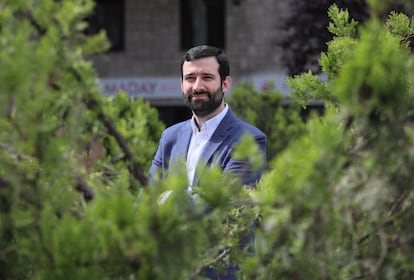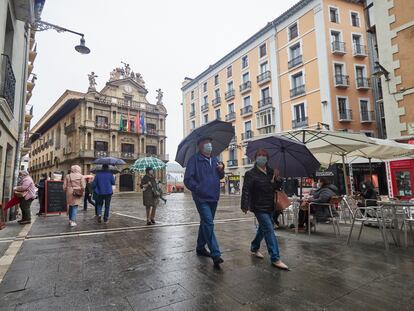The online detectives sowing doubts about the origins of the pandemic
A multi-faceted Twitter group, which includes a Spanish industrial engineer, has spent the past year investigating the possibility that the coronavirus did not emerge from a wet market in Wuhan

At the beginning of Spain’s coronavirus lockdown, 40-year-old industrial engineer Francisco de Asís de Ribera was out of work. A few weeks on, the Madrileño read a CNN news article that said China was restricting academic publications on the origins of SARS-CoV-2. Ribera shared the article on Twitter and began researching the issue online from his home in the Chamberí district of the Spanish capital. By May, he was part of a group of two dozen Twitter users from various countries who doubted the theory – at the time undisputed – that the coronavirus had emerged from a wet market in Wuhan. A year later, the work of this spontaneously formed group has helped to open a path of investigation into another possibility: the accidental escape of the virus from a laboratory in the Chinese city. The World Health Organization (WHO) continues to believe the former version, but the findings of this group have raised questions about how we consume information and how we classify ideas as conspiracy theories.
From Twitter threads and private conversations in direct message chats, Ribera and his fellow researchers organized themselves into a flexible group they called Drastic, an acronym for decentralized, radical, autonomous search team investigating Covid-19. The members still do not know each other personally and their relationship over the past months has been focused on sharing leads from buried documents and reflecting upon them openly, without attracting too much attention. Sticking to Twitter, their work has been to gather, translate and interpret clues scattered across the Chinese internet. “We chose Twitter by a process of elimination,” says Ribera. “On Facebook and Reddit any messages questioning the origin [of the coronavirus] were censored; on Twitter too, but less so.” They did not switch to a messaging platform because some of the participants wanted to remain anonymous.
There are new images from 2011 in Google Earth that I did not see a few months ago. There was an active area with buildings -now abandoned- only accessible by dirt road from Danaoshan at 1.4 km pic.twitter.com/sqVSzudnK6
— Francisco de Asis (@franciscodeasis) September 2, 2020
The group’s endeavors have led to an addendum in Nature magazine and prompted 10 international media teams, including the BBC, AP, Asahi and The Wall Street Journal, to undertake clandestine expeditions to a copper mine in Yunnan province in southern China about 1,500 kilometers from Wuhan in a bid to shed light on the origin of the virus.
In April 2012, six laborers between the ages of 30 and 63 went into the mine to clean a copper seam of bat feces. All became ill with pneumonia-like symptoms and three died without a definitive diagnosis. The symptoms were very similar to those experienced by Covid-19 victims, though not contagious.
“A small group of academics and internet sleuths has been working for months, using the networks to find each other and publish evidence of the Wuhan Institute of Virology’s activities, especially in relation to the mine,” says The Wall Street Journal’s May 24 report. Ribera has also signed three letters along with a small group of prominent academics in The New York Times, The Wall Street Journal and Le Monde, calling for more transparency concerning the origin of the pandemic. Meanwhile, the Chinese government has prevented all reporters from reaching the site of the mine or taking photographs of it.
“I was struck at first by the images on television of hospitals full of sick people and the number of victims,” says Rossana Segreto, an Italian microbiologist at the University of Innsbruck in Austria, who is also a member of Drastic. “Above all, I was struck by the idea that a virus that was new to humans could be so powerful.”
Segreto found that the virus Chinese researchers called RaTG13 in Nature in February, 2020, had already been named before as BtCo4491 by the Wuhan Institute of Virology. She believes that the discovery of that link is Drastic’s greatest contribution to research: “Yes, the link between RaTG13, BtCo4491 and the miners’ pneumonia, and the fact that the sequencing of RaTG13, had not been done after the start of the pandemic, as Nature 2020 said, but before, in 2018 [as the authors themselves ended up confirming in Nature in an addendum],” she says.
Details on the mine and the miners’ pneumonia came from a thesis and another academic text found in a Chinese archive by an anonymous Twitter user called The Seeker, who has been identified as a self-taught young man in his twenties who lives in eastern India, and whose career covers architecture, painting and film. “I started researching more than a year ago and I don’t know how to put it, but the more I looked, the more I felt I had to keep looking; the more questions came up and the more important the answers were,” he tells EL PAÍS via a direct message on Twitter.
The Analysis of 6 Patients with Severe Pneumonia Caused by Unknown Viruses (2013)https://t.co/1vYtLClbjA
— The Seeker (@TheSeeker268) May 18, 2020
Among the documents turned up by The Seeker’s search were the coordinates of Danaoshan, the village in southern China next to the mine. Last September, after analyzing Google Earth photos of the surrounding area, it occurred to Ribera to look at images from previous years, preserved by Google. In 2011 and 2015, in the middle of the expanse of green, there were some small buildings next to a warehouse. It could have been the entrance to the mine: “I was the first to suggest the exact location of the mine, but it’s a joint achievement,” says Ribera. “It was after The Seeker found the coordinates of the village. And later, with the help of other members of Drastic and other anonymous individuals, we have been able to confirm it.”
Ribera and his fellow researchers’ Twitter accounts contain a very long public conversation that mixes notes, findings and speculations. “Technology has made this whole story possible,” says Yuri Deigin, a Russian-Canadian entrepreneur and author of a lengthy April 2020 essay on the possibility of an accident at the Wuhan lab. “Search engines and public databases, including free access to scientific articles, was key. Also very useful were social networks as a means of exchanging ideas openly,” he says in a direct message on Twitter.
All of the research was conducted under the shadow of being labeled a conspiracy theorist – an inevitable consequence of doubting the origin of the virus a year ago. “I’ve learned to be on the conspiracy side of the fence; when I explained, we were called crazy,” says Ribera. “I don’t care. The best thing is to go your own way because nobody understands anything. You have to learn which battles to fight and to prioritize which evidence you want to present. When the truth is on the side usually reserved for conspiracies, you have to be very skeptical because you are surrounded by a lot of real conspiracies.”
Articles based on clues uncovered by Drastic have been circulating since July, 2020, when the British national newspaper The Times published a long feature on the hypotheses and the mine. But it was not until this year that the persistent trickle of discoveries has placed the origin of the virus under greater public scrutiny. In 2021, the WHO’s expedition to Wuhan failed to provide definitive evidence on the Chinese version; and three letters signed by another handful of academics dubbed The Paris Group by The New York Times (which includes Drastic members Ribera and Segreto, Gilles Demaneuf, a data scientist at the Bank of New Zealand, André Goffinet, a professor emeritus at the University of Leuven, and researcher Monali Rahalka from the Agharkar Institute in India), called for greater research into the origin of the coronavirus. Former New York Times reporter Nicholas Wade also wrote a lengthy article on SARS-CoV-2, The Wall Street Journal revealed that there were three possible coronavirus cases at the Wuhan Institute in November 2019 and even US President Joe Biden has ordered an investigation into the origin of the virus.
- Timeline of relevant visits to Yunnan for 2012-2015
— Francisco de Asis (@franciscodeasis) November 28, 2020
- Probable samples from the mineshaft for 2014-2015 (detail and summary) pic.twitter.com/wNf3rWDCtQ
None of this, of course, confirms anything. But today the voices calling for more transparency are impossible to ignore, though China does not tend to give in to such pressure. “One problem that the international community and journalists have is that they thought that the origin was going to be solved by a scientific journal article,” says Ribera. “People expect the origin of the coronavirus to come out one day in Nature. And it will. But the solution will not come from there alone. People forget that China is a dictatorship and that it is legitimate to doubt what they say because they have deceived us before.”
The multidisciplinary nature of the team has been one of its key assets, according to Ribera, both regarding Drastic and the so-called Paris Group. “There are people who know about virology, genetics, microbiology, molecular biology, epidemiology, medicine, pathology, zoology, biophysics, public health, bioinformatics, sociology, biosecurity and data analysis,” he explains. “People think this is only up to virologists and no one else should have a say. But that’s not so.”
While Ribera says he prefers not to calculate the hours he has spent on this topic, another anonymous member of the group, who goes by the pseudonym Billy Bostickson and sports an avatar of a wounded monkey, calculated that at a rate of $20 (€16.8) an hour, he had invested $40,000 (€33,522) worth of his time in the investigation. And that was only July of last year. The work is meticulous and requires a great deal of patience. “Maybe the secret services should be doing it,” says Ribera.
But the industrial engineer has the perfect credentials for the challenge. “I’ve worked as a technology consultant for many years, but my thing has always been numbers,” he says. He has several Excel pages with thousands of records for virus sequences, the first patients and trips through China from researchers at the Institute. “To me, it’s like a big sudoku,” he says. “My main value-add is searching, structuring and doing the plumbing, and the archeology on the data. It happens a lot that scientists have not properly understood the data and its biases before starting on their model.”
Ribera’s lack of haste was useful when it came to sifting through the Chinese PDF files so that Google and DeepL could translate them. Throughout this process, only one Chinese speaker has been involved, mainly to research the mine’s history.
English version by Heather Galloway.
Tu suscripción se está usando en otro dispositivo
¿Quieres añadir otro usuario a tu suscripción?
Si continúas leyendo en este dispositivo, no se podrá leer en el otro.
FlechaTu suscripción se está usando en otro dispositivo y solo puedes acceder a EL PAÍS desde un dispositivo a la vez.
Si quieres compartir tu cuenta, cambia tu suscripción a la modalidad Premium, así podrás añadir otro usuario. Cada uno accederá con su propia cuenta de email, lo que os permitirá personalizar vuestra experiencia en EL PAÍS.
¿Tienes una suscripción de empresa? Accede aquí para contratar más cuentas.
En el caso de no saber quién está usando tu cuenta, te recomendamos cambiar tu contraseña aquí.
Si decides continuar compartiendo tu cuenta, este mensaje se mostrará en tu dispositivo y en el de la otra persona que está usando tu cuenta de forma indefinida, afectando a tu experiencia de lectura. Puedes consultar aquí los términos y condiciones de la suscripción digital.
More information
Últimas noticias
Most viewed
- Sinaloa Cartel war is taking its toll on Los Chapitos
- Oona Chaplin: ‘I told James Cameron that I was living in a treehouse and starting a permaculture project with a friend’
- Reinhard Genzel, Nobel laureate in physics: ‘One-minute videos will never give you the truth’
- Why the price of coffee has skyrocketed: from Brazilian plantations to specialty coffee houses
- Silver prices are going crazy: This is what’s fueling the rally











































